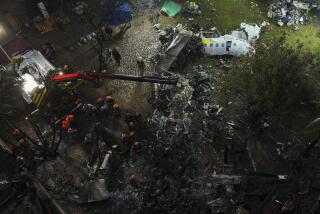SANTA CLARITA / ANTELOPE VALLEY : Air Force Tests Suspect Commuter Plane for Ice Risk : Aeronautics: European-built ATR 72 is the same type of craft that crashed in Indiana in October, killing 68 people.
- Share via
EDWARDS AIR FORCE BASE — A European-built ATR commuter aircraft began undergoing tests here Thursday to see if ice buildup on its wings may have been a factor in an October crash of the same type of plane that killed 68 people in Indiana.
A twin-engine ATR 72 turboprop flew behind an Air Force KC-135 tanker jet that sprayed water into the air, forming ice crystals on the commuter craft’s body. The ATR’s manufacturer, a consortium of French and Italian firms, paid the Air Force to conduct the tests.
Icing on the wings has been suspected as a cause of the Oct. 31 crash of an ATR 72 in Roselawn, Ind., near Chicago. The Federal Aviation Administration later banned ATR 72s and their sister planes, ATR 42s, from flying in weather likely to produce icy conditions. ATR 72s have 68 seats, while ATR 42s generally have 46.
ATRs, which have a range of 350 to 400 miles, are commuter workhorses in Midwestern and Eastern states. The 157 ATR 72s in service in this country are operated mainly by American Airlines’ American Eagle subsidiary, Continental Express and Trans World Express. None are flown in California.
After the Roselawn crash, the FAA said ATRs were still safe in all conditions. But the agency later changed its position and imposed the icy-weather ban after some pilots expressed reluctance to fly the planes in such conditions and the National Transportation Safety Board recommended flight restrictions.
The FAA said it ordered the ban because new information from the manufacturer, Avions de Transport Regional, about potential hazards of icy conditions showed that control could be lost in certain situations. The agency said the craft remained safe to fly in good weather.
ATR, however, issued a statement arguing that voluntary tests it conducted “provide no bases for the action taken by the FAA.” The cause of the crash remains under investigation by the National Transportation Safety Board.
Kathryn Creedy, a spokeswoman for ATR Marketing, said the plane’s manufacturer conducted wind-tunnel tests for ice problems, using wooden models of ice formations, and is now performing in-flight tests at Edwards. The Air Force hires out its facilities to civilian firms if they cannot find the same services in the private sector.
Creedy said one early theory on the cause of the Roselawn crash was ice forming on the ATR’s aileron, a movable flap that controls an aircraft’s roll.
“We are as mystified as the FAA and the NTSB,” Creedy said. “We want to know what happened to that flight.”
Some aviation experts said that before the October crash, ATRs were generally recognized as superior planes with a good safety record. But authorities now say that the craft’s smaller, fuel-efficient wings and tail may be especially susceptible to icing.
In icing conditions, water remains liquid in the air until it encounters a surface--such as an airplane wing--on which to freeze. Ice buildup can disrupt airflow over wings, causing them to lose lift.
More to Read
Inside the business of entertainment
The Wide Shot brings you news, analysis and insights on everything from streaming wars to production — and what it all means for the future.
You may occasionally receive promotional content from the Los Angeles Times.









